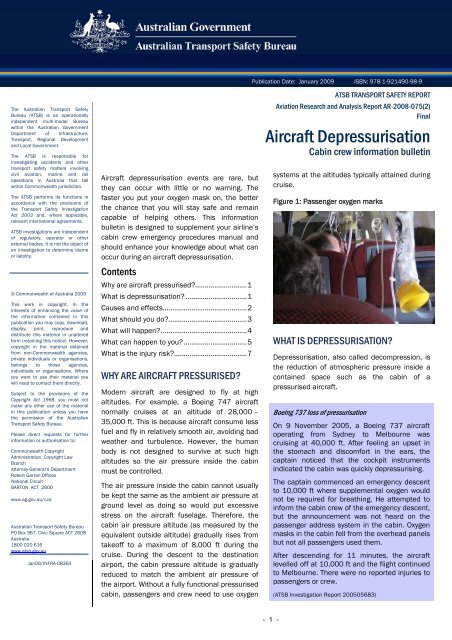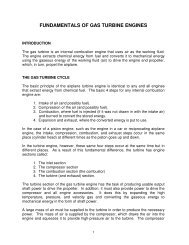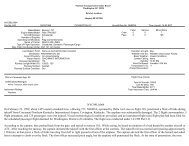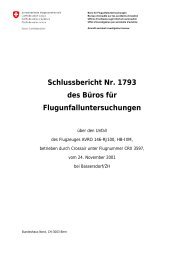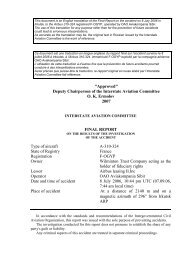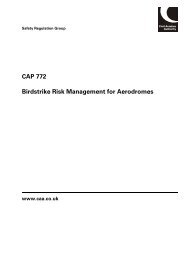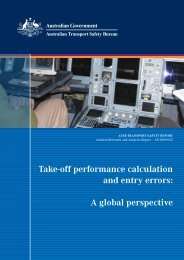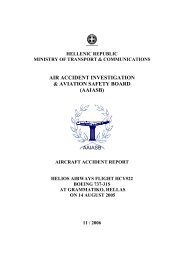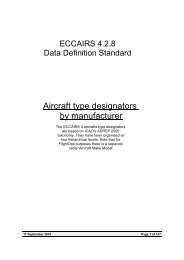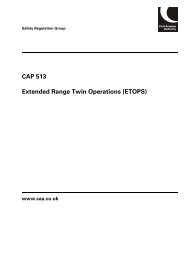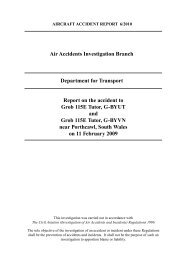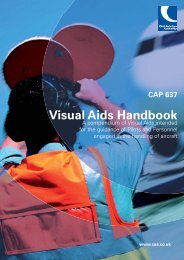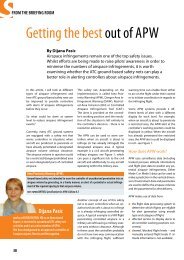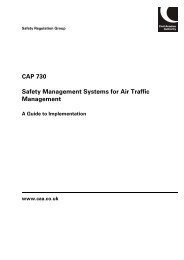Staying safe during an aircraft depressurisation - SKYbrary
Staying safe during an aircraft depressurisation - SKYbrary
Staying safe during an aircraft depressurisation - SKYbrary
You also want an ePaper? Increase the reach of your titles
YUMPU automatically turns print PDFs into web optimized ePapers that Google loves.
The Australi<strong>an</strong> Tr<strong>an</strong>sport Safety<br />
Bureau (ATSB) is <strong>an</strong> operationally<br />
independent multi-modal Bureau<br />
within the Australi<strong>an</strong> Government<br />
Department of Infrastructure,<br />
Tr<strong>an</strong>sport, Regional Development<br />
<strong>an</strong>d Local Government.<br />
The ATSB is responsible for<br />
investigating accidents <strong>an</strong>d other<br />
tr<strong>an</strong>sport <strong>safe</strong>ty matters involving<br />
civil aviation, marine <strong>an</strong>d rail<br />
operations in Australia that fall<br />
within Commonwealth jurisdiction.<br />
The ATSB performs its functions in<br />
accord<strong>an</strong>ce with the provisions of<br />
the Tr<strong>an</strong>sport Safety Investigation<br />
Act 2003 <strong>an</strong>d, where applicable,<br />
relev<strong>an</strong>t international agreements.<br />
ATSB investigations are independent<br />
of regulatory, operator or other<br />
external bodies. It is not the object of<br />
<strong>an</strong> investigation to determine blame<br />
or liability.<br />
© Commonwealth of Australia 2009<br />
This work is copyright. In the<br />
interests of enh<strong>an</strong>cing the value of<br />
the information contained in this<br />
publication you may copy, download,<br />
display, print, reproduce <strong>an</strong>d<br />
distribute this material in unaltered<br />
form (retaining this notice). However,<br />
copyright in the material obtained<br />
from non-Commonwealth agencies,<br />
private individuals or org<strong>an</strong>isations,<br />
belongs to those agencies,<br />
individuals or org<strong>an</strong>isations. Where<br />
you w<strong>an</strong>t to use their material you<br />
will need to contact them directly.<br />
Subject to the provisions of the<br />
Copyright Act 1968, you must not<br />
make <strong>an</strong>y other use of the material<br />
in this publication unless you have<br />
the permission of the Australi<strong>an</strong><br />
Tr<strong>an</strong>sport Safety Bureau.<br />
Please direct requests for further<br />
information or authorisation to:<br />
Commonwealth Copyright<br />
Administration, Copyright Law<br />
Br<strong>an</strong>ch<br />
Attorney-General’s Department<br />
Robert Garr<strong>an</strong> Offices<br />
National Circuit<br />
BARTON ACT 2600<br />
www.ag.gov.au/cca<br />
Australi<strong>an</strong> Tr<strong>an</strong>sport Safety Bureau<br />
PO Box 967, Civic Square ACT 2608<br />
Australia<br />
1800 020 616<br />
www.atsb.gov.au<br />
J<strong>an</strong>09/INFRA-08364<br />
Aircraft <strong>depressurisation</strong> events are rare, but<br />
they c<strong>an</strong> occur with little or no warning. The<br />
faster you put your oxygen mask on, the better<br />
the ch<strong>an</strong>ce that you will stay <strong>safe</strong> <strong>an</strong>d remain<br />
capable of helping others. This information<br />
bulletin is designed to supplement your airline’s<br />
cabin crew emergency procedures m<strong>an</strong>ual <strong>an</strong>d<br />
should enh<strong>an</strong>ce your knowledge about what c<strong>an</strong><br />
occur <strong>during</strong> <strong>an</strong> <strong>aircraft</strong> <strong>depressurisation</strong>.<br />
Contents<br />
Why are <strong>aircraft</strong> pressurised? ........................... 1<br />
What is <strong>depressurisation</strong>? ................................ 1<br />
Causes <strong>an</strong>d effects ............................................ 2<br />
What should you do? ......................................... 3<br />
What will happen? ............................................. 4<br />
What c<strong>an</strong> happen to you? ................................. 5<br />
What is the injury risk? ...................................... 7<br />
WHY ARE AIRCRAFT PRESSURISED?<br />
Modern <strong>aircraft</strong> are designed to fly at high<br />
altitudes. For example, a Boeing 747 <strong>aircraft</strong><br />
normally cruises at <strong>an</strong> altitude of 28,000 –<br />
35,000 ft. This is because <strong>aircraft</strong> consume less<br />
fuel <strong>an</strong>d fly in relatively smooth air, avoiding bad<br />
weather <strong>an</strong>d turbulence. However, the hum<strong>an</strong><br />
body is not designed to survive at such high<br />
altitudes so the air pressure inside the cabin<br />
must be controlled.<br />
The air pressure inside the cabin c<strong>an</strong>not usually<br />
be kept the same as the ambient air pressure at<br />
ground level as doing so would put excessive<br />
stress on the <strong>aircraft</strong> fuselage. Therefore, the<br />
cabin air pressure altitude (as measured by the<br />
equivalent outside altitude) gradually rises from<br />
takeoff to a maximum of 8,000 ft <strong>during</strong> the<br />
cruise. During the descent to the destination<br />
airport, the cabin pressure altitude is gradually<br />
reduced to match the ambient air pressure of<br />
the airport. Without a fully functional pressurised<br />
cabin, passengers <strong>an</strong>d crew need to use oxygen<br />
Publication Date: J<strong>an</strong>uary 2009 ISBN: 978-1-921490-98-9<br />
- 1 -<br />
ATSB TRANSPORT SAFETY REPORT<br />
Aviation Research <strong>an</strong>d Analysis Report AR-2008-075(2)<br />
Final<br />
Aircraft Depressurisation<br />
Cabin crew information bulletin<br />
systems at the altitudes typically attained <strong>during</strong><br />
cruise.<br />
Figure 1: Passenger oxygen marks<br />
WHAT IS DEPRESSURISATION?<br />
Depressurisation, also called decompression, is<br />
the reduction of atmospheric pressure inside a<br />
contained space such as the cabin of a<br />
pressurised <strong>aircraft</strong>.<br />
Boeing 737 loss of pressurisation<br />
On 9 November 2005, a Boeing 737 <strong>aircraft</strong><br />
operating from Sydney to Melbourne was<br />
cruising at 40,000 ft. After feeling <strong>an</strong> upset in<br />
the stomach <strong>an</strong>d discomfort in the ears, the<br />
captain noticed that the cockpit instruments<br />
indicated the cabin was quickly depressurising.<br />
The captain commenced <strong>an</strong> emergency descent<br />
to 10,000 ft where supplemental oxygen would<br />
not be required for breathing. He attempted to<br />
inform the cabin crew of the emergency descent,<br />
but the <strong>an</strong>nouncement was not heard on the<br />
passenger address system in the cabin. Oxygen<br />
masks in the cabin fell from the overhead p<strong>an</strong>els<br />
but not all passengers used them.<br />
After descending for 11 minutes, the <strong>aircraft</strong><br />
levelled off at 10,000 ft <strong>an</strong>d the flight continued<br />
to Melbourne. There were no reported injuries to<br />
passengers or crew.<br />
(ATSB Investigation Report 200505683)
CAUSES AND EFFECTS<br />
Types of <strong>depressurisation</strong><br />
Three types of <strong>depressurisation</strong> are generally<br />
distinguished from each other (Mohler, 2000;<br />
Reinhart, 1996).<br />
• An explosive <strong>depressurisation</strong> occurs in less<br />
th<strong>an</strong> half a second. This usually only occurs<br />
in small <strong>aircraft</strong> flying at very high altitudes.<br />
• A rapid <strong>depressurisation</strong> is more common<br />
<strong>an</strong>d is usually associated with larger <strong>aircraft</strong>.<br />
Depressurisation occurs in a matter of<br />
seconds at a rate greater th<strong>an</strong> 7,000 ft/min,<br />
<strong>an</strong>d is normally associated with a ‘b<strong>an</strong>g’ <strong>an</strong>d<br />
a sudden fogging of the cabin air.<br />
• A gradual or subtle <strong>depressurisation</strong> occurs<br />
over a longer time <strong>an</strong>d due to the gradual<br />
ch<strong>an</strong>ge in air pressure. It c<strong>an</strong> be difficult to<br />
recognise before oxygen masks fall from the<br />
cabin ceiling.<br />
In addition to losing cabin air pressure, there<br />
have been cases of <strong>aircraft</strong> failing to pressurise<br />
after takeoff. If this is not detected <strong>an</strong>d corrected<br />
by the flight crew before the <strong>aircraft</strong> reaches<br />
cruising altitude, the lack of pressurisation c<strong>an</strong><br />
also be difficult to recognise.<br />
Depressurisation occurrences<br />
The ch<strong>an</strong>ces of a <strong>depressurisation</strong> problem<br />
occurring are very low, but it does happen. In<br />
the last 10 years 1 , the ATSB has recorded 310<br />
occurrences (including 124 from high capacity<br />
passenger <strong>aircraft</strong> 2 ) where <strong>an</strong> <strong>aircraft</strong><br />
pressurisation problem was cited. Although the<br />
<strong>depressurisation</strong>s often occurred quickly, only<br />
two of these occurrences included evidence of a<br />
rapid <strong>depressurisation</strong> (a rate greater th<strong>an</strong><br />
7,000 ft/min).<br />
Causes of <strong>depressurisation</strong>s r<strong>an</strong>ged from leaking<br />
door seals <strong>an</strong>d incorrect system mode selection<br />
by flight crew to mech<strong>an</strong>ical-related problems.<br />
1 September 1998 to August 2008.<br />
2 High capacity <strong>aircraft</strong> have more th<strong>an</strong> 38 passenger<br />
seats.<br />
In the majority of cases, the flight crew took<br />
some form of action such as descending the<br />
<strong>aircraft</strong> to a lower altitude, actioning the<br />
appropriate checklists, or diverting the <strong>aircraft</strong> to<br />
a nearby aerodrome. The deployment of oxygen<br />
masks was clearly identifiable in 57 of the 310<br />
occurrences.<br />
What causes <strong>depressurisation</strong>?<br />
Failure of the pressure control system<br />
The most common cause of pressurisation<br />
system failures is the malfunction of the relev<strong>an</strong>t<br />
control system. This c<strong>an</strong> be caused by the<br />
failure of the outflow valves that maintain cabin<br />
altitude at the desirable level.<br />
Reduced cabin air inflow<br />
Depressurisation events c<strong>an</strong> be attributed to air<br />
inflow failure. Typical inhibitors of fresh cabin air<br />
inflow include unserviceable components in the<br />
air-conditioning system or the malfunction of <strong>an</strong><br />
engine or compressor.<br />
Structural failure<br />
Aircraft structural failures that c<strong>an</strong> lead to<br />
<strong>depressurisation</strong> include the impaired sealing of<br />
a door or window, cracked windows, improperly<br />
closed doors, loss of a complete door or window,<br />
or a gross structural failure of the cabin wall. A<br />
recent example of a fuselage rupture was a<br />
Boeing 747 in July 2008. Most structural failures<br />
have been caused by door or window problems.<br />
Boeing 747-400 <strong>depressurisation</strong><br />
On 25 July 2008, a Boeing 747-400 <strong>aircraft</strong> with<br />
365 persons on board departed Hong Kong on a<br />
scheduled flight to Melbourne.<br />
Approximately 55 minutes into the flight, while<br />
the <strong>aircraft</strong> was cruising at 29,000 ft, a loud<br />
b<strong>an</strong>g was heard by passengers <strong>an</strong>d crew. This<br />
was followed by the rapid <strong>depressurisation</strong> of<br />
the cabin, <strong>during</strong> which time oxygen masks<br />
dropped from the overhead compartments. The<br />
flight crew commenced a descent to 10,000 ft<br />
<strong>an</strong>d diverted the <strong>aircraft</strong> to M<strong>an</strong>ila. The <strong>aircraft</strong><br />
l<strong>an</strong>ded <strong>safe</strong>ly.<br />
- 2 -<br />
(ATSB Preliminary Investigation Report AO-2008-053)
Figure 2: An example of a passenger <strong>safe</strong>ty card showing how to use oxygen masks<br />
WHAT SHOULD YOU DO?<br />
It is imperative that you underst<strong>an</strong>d what to do<br />
<strong>an</strong>d how to use the emergency equipment if a<br />
<strong>depressurisation</strong> happens.<br />
1. Put the nearest oxygen mask on immediately<br />
Oxygen is the only treatment for hypoxia (see<br />
page 5) <strong>an</strong>d is critical for your survival. For<br />
example, in the case of rapid <strong>depressurisation</strong> at<br />
35,000 ft, you may have much less th<strong>an</strong> one<br />
minute to put your oxygen mask on before you<br />
begin to lose consciousness.<br />
Don’t try to go to your assigned crew position or<br />
seat if you are not close by. Use the closest<br />
available oxygen mask.<br />
Stay calm <strong>an</strong>d breathe normally if you c<strong>an</strong>.<br />
Hyperventilation <strong>an</strong>d physical activity is not<br />
helpful, as more oxygen is required for the body<br />
to function.<br />
If you feel worse immediately after putting your<br />
oxygen mask on, do not take it off. This<br />
condition is called the ‘oxygen paradox’, <strong>an</strong>d is<br />
simply the body’s reaction to a sudden intake of<br />
oxygen after being exposed to hypoxia. You will<br />
only feel unwell for less th<strong>an</strong> one minute<br />
(Harding, 1999).<br />
2. Secure yourself as best you c<strong>an</strong><br />
Once you are breathing through <strong>an</strong> oxygen mask,<br />
secure yourself the best you c<strong>an</strong>. Cabin crew<br />
must look after their own <strong>safe</strong>ty by remaining<br />
- 3 -<br />
secured. This may be in a spare passenger seat<br />
or wedged between two passengers. If a crew<br />
member puts their own <strong>safe</strong>ty at risk <strong>an</strong>d is<br />
injured, there will be one less trained <strong>safe</strong>ty<br />
professional who c<strong>an</strong> assist if the emergency<br />
escalates.<br />
3. Help others only after you have put your<br />
oxygen mask on<br />
You may not have time to assist others near you<br />
<strong>an</strong>d then put on your mask before you become<br />
unconscious, so put your mask on before you<br />
instruct or help others with their masks.<br />
Normally, people recover from symptoms of<br />
hypoxia rapidly <strong>an</strong>d completely after breathing<br />
sufficient oxygen.<br />
4. Depressurisation follow-up duties<br />
The flight crew will inform you when it is <strong>safe</strong> to<br />
begin follow-up duties. These typically include<br />
moving through the cabin to identify <strong>an</strong>d help<br />
passengers <strong>an</strong>d other crew who may be injured<br />
or need assist<strong>an</strong>ce.<br />
Walking through the cabin will result in your body<br />
requiring more oxygen th<strong>an</strong> what is required by<br />
passengers who are still seated. For this reason,<br />
cabin crew will need to use portable oxygen<br />
when moving through the cabin, even though<br />
passengers may no longer need to use their<br />
oxygen mask. It is import<strong>an</strong>t that passengers<br />
remain in their seats with their seatbelts<br />
fastened unless advised differently by the flight<br />
crew.
Using the supplemental oxygen<br />
An individual oxygen dispensing unit is required<br />
for every passenger <strong>an</strong>d crew member on<br />
pressurised <strong>aircraft</strong>. 3 To account for inf<strong>an</strong>ts,<br />
there will generally be more oxygen units th<strong>an</strong><br />
there are passenger seats. Apart from above<br />
passenger seats, oxygen masks will also deploy<br />
in the toilets, crew rest, cabin crew seating<br />
positions, <strong>an</strong>d in<br />
some galleys.<br />
Do not be alarmed if<br />
the reservoir bag<br />
does not inflate.<br />
When oxygen is<br />
flowing through the<br />
mask, the reservoir<br />
bag may or may not<br />
inflate depending on<br />
the cabin altitude<br />
<strong>an</strong>d your breathing.<br />
The flow of oxygen to<br />
the mask is in a slow<br />
continuous stream,<br />
so you will not feel<br />
the oxygen blow out<br />
to your face.<br />
It c<strong>an</strong> be difficult to<br />
feel that oxygen is flowing. However, if you c<strong>an</strong><br />
breathe, then it is flowing. In addition, most<br />
masks have a flow indicator, such as a small<br />
green ‘balloon’ integrated into the reservoir bag<br />
or in the tubing.<br />
Oxygen is either supplied through individual<br />
chemical generators for each group of masks, or<br />
through a common gaseous oxygen supply from<br />
oxygen bottles. Chemical generators c<strong>an</strong><br />
produce a smoke-like smell from the reaction.<br />
This is normal, but the smell may concern some<br />
passengers.<br />
Will you have enough oxygen?<br />
All Australi<strong>an</strong>-registered <strong>aircraft</strong> flying above<br />
10,000 ft are required to have provision for<br />
supplemental oxygen. 4 Enough supplemental<br />
oxygen is carried so that the <strong>aircraft</strong> c<strong>an</strong><br />
descend to 10,000 ft with everyone having<br />
enough oxygen. However, only a limited supply<br />
3 Civil Aviation Order (CAO) 108.26.<br />
4 Civil Aviation Order (CAO) 20.4.<br />
Figure 3: Pull down mask<br />
to start the flow of oxygen<br />
- 4 -<br />
c<strong>an</strong> be carried on <strong>an</strong> <strong>aircraft</strong>, so supplemental<br />
oxygen c<strong>an</strong>not be used indefinitely.<br />
WHAT WILL HAPPEN?<br />
Explosive <strong>an</strong>d rapid <strong>depressurisation</strong>s are easily<br />
identified as they are accomp<strong>an</strong>ied by a loud<br />
‘b<strong>an</strong>g’, flying debris (such as paper <strong>an</strong>d dust),<br />
sudden fogging of the air, <strong>an</strong>d dropping<br />
temperature. However, most <strong>depressurisation</strong><br />
events are gradual <strong>an</strong>d are harder to detect due<br />
to the slow increase in cabin altitude.<br />
Commercial <strong>aircraft</strong> are required to provide<br />
warnings to the flight crew if the cabin altitude<br />
climbs above 8,000 ft. 5 The flight crew will<br />
receive a cockpit warning when the cabin<br />
altitude reaches 10,000 ft. The passenger<br />
oxygen masks should automatically deploy<br />
before the cabin altitude reaches 15,000 ft.<br />
Some <strong>aircraft</strong> also have <strong>an</strong> automated<br />
<strong>an</strong>nouncement telling passengers to put on the<br />
oxygen masks when they drop.<br />
In some <strong>aircraft</strong>, <strong>an</strong> emergency pressurisation<br />
system is also fitted that automatically routes<br />
hot, high pressure, high velocity engine bleed air<br />
directly into the cabin to regulate the pressure.<br />
What is the flight crew’s response to a<br />
<strong>depressurisation</strong> event?<br />
When flight crew notice that the <strong>aircraft</strong> is<br />
experiencing a pressurisation problem or a<br />
<strong>depressurisation</strong>, they will conduct a series of<br />
emergency procedures.<br />
Procedures for flight crew involve firstly donning<br />
their own oxygen masks <strong>an</strong>d then working<br />
through a checklist. The flight crew are unlikely<br />
to have time to make <strong>an</strong> <strong>an</strong>nouncement to the<br />
cabin. If necessary, the flight crew will<br />
immediately commence a descent to 10,000 ft<br />
or to the lowest <strong>safe</strong> altitude that terrain permits.<br />
The <strong>aircraft</strong>’s supplemental oxygen supply is<br />
finite, so <strong>an</strong>y delay in commencing the descent<br />
to a <strong>safe</strong> breathing altitude may increase the risk<br />
of injury to crew <strong>an</strong>d passengers. A rapid descent<br />
also minimises the time passengers <strong>an</strong>d crew<br />
are exposed to cold temperatures <strong>an</strong>d minimises<br />
the risk of decompression sickness (see page 6).<br />
5 Civil Aviation Regulation (CAR) Part 25.
The flight crew will also broadcast a ‘MAYDAY’ or<br />
‘PAN PAN’ (the international call for urgent<br />
assist<strong>an</strong>ce) message to declare <strong>an</strong> emergency<br />
descent after their oxygen masks are secured.<br />
This will make air traffic control <strong>an</strong>d other<br />
<strong>aircraft</strong> in the area aware of the situation,<br />
including the need for <strong>an</strong> emergency descent to<br />
a lower altitude.<br />
After descending to a lower altitude, the flight<br />
crew will decide whether it is <strong>safe</strong> to continue<br />
the flight to the pl<strong>an</strong>ned destination or if a<br />
diversion to the nearest suitable airport is<br />
required. This decision depends on the<br />
circumst<strong>an</strong>ces of the <strong>depressurisation</strong>, the<br />
condition of the <strong>aircraft</strong>, <strong>an</strong>d the health <strong>an</strong>d<br />
<strong>safe</strong>ty of passengers <strong>an</strong>d crew members.<br />
Once the <strong>aircraft</strong> is at a <strong>safe</strong> altitude, the flight<br />
crew will advise when it is <strong>safe</strong> for passengers to<br />
remove their mask. They will also inform cabin<br />
crew when they c<strong>an</strong> begin their follow-up duties.<br />
WHAT CAN HAPPEN TO YOU?<br />
Loss of cabin pressure in a pressurised <strong>aircraft</strong><br />
exposes passengers <strong>an</strong>d crew to a high altitude<br />
environment with <strong>an</strong> extremely low temperature<br />
<strong>an</strong>d lower atmospheric pressure with less<br />
oxygen.<br />
The most common problems associated with<br />
being directly exposed to the atmosphere at high<br />
altitudes are hypoxia, pain from trapped gas in<br />
the body, cold-related injuries, <strong>an</strong>d<br />
decompression sickness.<br />
Hypoxia <strong>an</strong>d loss of consciousness<br />
The most serious hazard when exposed to high<br />
altitudes is hypoxia. Hypoxia is caused by less<br />
oxygen being available <strong>an</strong>d the reduced ability of<br />
our body to use the oxygen that is available. The<br />
major symptoms <strong>an</strong>d signs of hypoxia include:<br />
• light headedness or dizziness<br />
• blurred or tunnel vision<br />
• headache or nausea<br />
• diminished hearing<br />
• tingling or numbness of finger tips.<br />
The effects of hypoxia become more signific<strong>an</strong>t<br />
when exposed to <strong>an</strong> altitude above 10,000 ft.<br />
However, it c<strong>an</strong> be difficult to notice m<strong>an</strong>y of<br />
these symptoms because you may, at the same<br />
time, be experiencing loss of judgement <strong>an</strong>d selfawareness,<br />
having difficulties concentrating, <strong>an</strong>d<br />
impaired memory. If oxygen is not administered,<br />
unconsciousness will follow.<br />
Payne Stewart’s last round<br />
In October 1999, US golfer Payne Stewart’s<br />
<strong>aircraft</strong> crashed when its fuel supply had been<br />
exhausted. The <strong>aircraft</strong>, a light corporate jet, was<br />
destroyed <strong>an</strong>d all six occup<strong>an</strong>ts on board,<br />
including Stewart, were killed. It is believed that<br />
the accident may have been related to<br />
<strong>depressurisation</strong>, <strong>an</strong>d the pilots <strong>an</strong>d passengers<br />
may have been incapacitated by hypoxia.<br />
- 5 -<br />
Time of useful consciousness (also known as<br />
effective perform<strong>an</strong>ce time) is the amount of<br />
time crew <strong>an</strong>d passengers c<strong>an</strong> continue to<br />
conduct duties <strong>an</strong>d activities in <strong>an</strong> environment<br />
with inadequate oxygen. It is measured from the<br />
time when the occup<strong>an</strong>ts of the <strong>aircraft</strong> are<br />
exposed to a low-pressure environment to the<br />
time when the occup<strong>an</strong>ts have lost the capability<br />
to take corrective <strong>an</strong>d protective actions, such as<br />
self-administer oxygen.<br />
The time of useful consciousness is depend<strong>an</strong>t<br />
on the pressure altitude inside the cabin<br />
following the <strong>depressurisation</strong> (Table 1). This c<strong>an</strong><br />
be considerably lower th<strong>an</strong> the <strong>aircraft</strong>’s altitude<br />
before the <strong>aircraft</strong> has fully depressurised.<br />
Table 1: Time of useful consciousness (TUC)<br />
Cabin Pressure<br />
Altitude (ft)<br />
TUC<br />
15,000 More th<strong>an</strong> 30 min<br />
18,000 20 – 30 min<br />
22,000 10 min<br />
25,000 3 – 5 min<br />
28,000 2.5 – 3 min<br />
30,000 1 – 2 min<br />
35,000 30 sec – 1 min<br />
40,000 15 – 20 sec<br />
Source: Reinhart, 1996
The actual time of useful consciousness will be<br />
shorter with faster rates of <strong>aircraft</strong><br />
<strong>depressurisation</strong> or if you are exercising (such as<br />
running to your seat). Hypoxia symptoms c<strong>an</strong><br />
also be worse <strong>an</strong>d time of useful consciousness<br />
shorter for people with respiratory or heart<br />
conditions, who are smokers or are unfit, or have<br />
been drinking alcohol.<br />
Physiological altitude<br />
If a passenger is a smoker or is physically out of<br />
shape, they will be at greater risk of altitude<br />
injuries th<strong>an</strong> a physically fit person.<br />
Smoking three cigarettes in rapid succession, or<br />
smoking 20-30 cigarettes in a 24-hour period<br />
prior to flying c<strong>an</strong> tr<strong>an</strong>slate into a physiological<br />
altitude of <strong>an</strong> additional 3,000 to 5,000 ft.<br />
Source: Reinhart, 1996<br />
Trapped gas<br />
Air travellers may experience discomfort <strong>an</strong>d<br />
pain in their middle ear, sinuses, teeth, or<br />
stomach when the <strong>aircraft</strong> is climbing or<br />
descending. This is because our bodies contain<br />
gas in these cavities, <strong>an</strong>d the gas is influenced<br />
by the ch<strong>an</strong>ges in the pressure outside the body<br />
(i.e. the cabin air pressure).<br />
It is more difficult for gas to ‘equalise’ in the<br />
middle ear cavity when the cabin pressure<br />
altitude is descending th<strong>an</strong> when it is climbing.<br />
In addition, a person’s level of discomfort<br />
depends on the rate at which the cabin altitude<br />
ch<strong>an</strong>ges. When the <strong>aircraft</strong> is climbing or<br />
descending, the cabin pressure altitude is<br />
generally increased or decreased at a rate of no<br />
more th<strong>an</strong> about 300-500 ft/min to minimise<br />
passenger discomfort (MacMill<strong>an</strong>, 1999).<br />
However, <strong>during</strong> <strong>an</strong> explosive or rapid<br />
<strong>depressurisation</strong>, the cabin pressure altitude c<strong>an</strong><br />
climb at a considerably higher rate (see box in<br />
the next column) <strong>an</strong>d c<strong>an</strong> result in pain. A rapid<br />
<strong>aircraft</strong> descent following a <strong>depressurisation</strong> c<strong>an</strong><br />
also lead to pain, sometimes worse th<strong>an</strong> the<br />
pain associated with the actual <strong>depressurisation</strong>.<br />
This is because it is more difficult for the inner<br />
ear to equalise when the altitude of the cabin is<br />
decreasing (such as from a rapid <strong>aircraft</strong><br />
descent) th<strong>an</strong> climbing (such as from a<br />
<strong>depressurisation</strong>). The pain experienced c<strong>an</strong> be<br />
worse if passengers have ear <strong>an</strong>d nose<br />
infections. In severe cases, the eardrum c<strong>an</strong><br />
rupture, causing bleeding or leaking of fluid from<br />
the ear.<br />
In a similar way to ear pain, air pressure in the<br />
sinuses equalises with the ambient air pressure<br />
in the cabin through small openings that connect<br />
the sinuses to the nose. If you fly with <strong>an</strong> upper<br />
respiratory infection or hay fever, the gas inside<br />
the sinuses may not escape to equalise the<br />
pressure. As a result, you may experience pain in<br />
the cheeks, forehead or sinuses when the cabin<br />
pressure altitude is descending.<br />
As gas inside your teeth <strong>an</strong>d the gastrointestinal<br />
tract exp<strong>an</strong>ds at high altitudes, a rapid<br />
<strong>depressurisation</strong> c<strong>an</strong> result in discomfort,<br />
bloating <strong>an</strong>d pain. Pain from trapped gas<br />
becomes more signific<strong>an</strong>t if you are suddenly<br />
exposed to cabin altitudes above 25,000 ft.<br />
Boeing 747-400 <strong>depressurisation</strong><br />
The rapid <strong>depressurisation</strong> on the Boeing 747-<br />
400 <strong>aircraft</strong> on 25 July 2008 occurred when the<br />
<strong>aircraft</strong> was cruising at 29,000 ft <strong>an</strong>d the<br />
pressure inside the cabin was equivalent to <strong>an</strong><br />
altitude of 3,700 ft.<br />
Following the <strong>depressurisation</strong>, the cabin<br />
pressure altitude increased to a maximum of<br />
25,900 ft in 41 seconds, increasing by about<br />
60,000 ft/min in the first 20 seconds.<br />
About 20 seconds after the event, the <strong>aircraft</strong><br />
beg<strong>an</strong> to descend to 10,000 ft over about 5 <strong>an</strong>d<br />
a half minutes. During this time, the cabin<br />
altitude slowly reduced from 25,900 ft to<br />
8,000 ft.<br />
- 6 -<br />
(ATSB Preliminary Investigation Report AO-2008-053)<br />
Decompression sickness <strong>an</strong>d cold<br />
injuries<br />
Decompression sickness is caused by the<br />
development of nitrogen bubbles in the body as<br />
a result of reduced atmospheric pressure.<br />
However, it occurs at a much lower rate in<br />
aviation th<strong>an</strong> in SCUBA diving. There have been<br />
no cases recorded of decompression sickness<br />
when exposed to altitudes less th<strong>an</strong> 18,000 ft<br />
(without recent SCUBA diving or hyperbaric<br />
exposure).
Decompression sickness normally only occurs<br />
following long exposures (more th<strong>an</strong> half <strong>an</strong><br />
hour) to altitudes above 25,000 ft. The most<br />
common symptom of decompression sickness is<br />
‘the bends’, m<strong>an</strong>ifested by pain in <strong>an</strong>d around<br />
the large joints of the body (Heimbach &<br />
Sheffield, 1996).<br />
Safety tip: diving <strong>an</strong>d flying<br />
Don’t fly until at least 48 hours after SCUBA<br />
diving involving deep dives or dives with<br />
decompression stops, to give your body enough<br />
time to rid itself of excess nitrogen.<br />
In the event of a <strong>depressurisation</strong>, some crew<br />
<strong>an</strong>d passengers may be exposed to extremely<br />
cold temperatures (down to -56ºC at higher<br />
altitudes). Exposure to these temperatures c<strong>an</strong><br />
result in injuries such as hypothermia <strong>an</strong>d<br />
frostbite.<br />
Since the flight crew usually initiate <strong>an</strong><br />
emergency descent when the cabin loses<br />
pressure, the risk of decompression sickness<br />
<strong>an</strong>d cold-related injuries is very low.<br />
WHAT IS THE INJURY RISK?<br />
The ch<strong>an</strong>ces of being injured in a<br />
<strong>depressurisation</strong> event are low. In a review of all<br />
Australi<strong>an</strong> pressurisation failure related<br />
occurrences over a 30 year period 6 , Newm<strong>an</strong><br />
(2006) found only ten events that involved<br />
hypoxia, injury or death.<br />
Only one occurrence resulted in fatal injuries<br />
(see ‘Ghost Flight’ box in next column). Of the<br />
four events in which hypoxia symptoms were<br />
reported, one involved the pilot losing<br />
consciousness, while the other cases involved<br />
occup<strong>an</strong>ts reporting mild symptoms of hypoxia.<br />
6 Occurrences reviewed for J<strong>an</strong>uary 1975 to March 2006.<br />
Ghost flight<br />
On 4 September 2000, a Beech Super King Air<br />
200 <strong>aircraft</strong>, operating as a charter with one<br />
pilot <strong>an</strong>d seven passengers, departed Perth for<br />
Leonora, Western Australia. Five hours later, the<br />
<strong>aircraft</strong> impacted the ground in remote<br />
Queensl<strong>an</strong>d. The <strong>aircraft</strong> was destroyed on<br />
impact, with all persons on board fatally injured.<br />
The investigation concluded that the pilot <strong>an</strong>d<br />
passengers were most likely incapacitated as a<br />
result of hypoxia due to the <strong>aircraft</strong> not being<br />
pressurised <strong>an</strong>d the occup<strong>an</strong>ts not receiving<br />
supplemental oxygen.<br />
(ATSB Investigation Report 200003771)<br />
There were four occurrences in which<br />
passengers sustained minor ear problems, but<br />
no reported cases of decompression sickness or<br />
cold-related injuries.<br />
Cracked windscreen<br />
On 2 December 2005, a Boeing 737 cockpit<br />
window cracked while cruising at 37,000 ft. The<br />
subsequent flight crew actions resulted in rapid<br />
ch<strong>an</strong>ges in cabin pressure. Eleven of the 99<br />
passengers sustained minor ear <strong>an</strong>d/or nose<br />
injuries.<br />
(ATSB Investigation Report 200506298)<br />
- 7 -<br />
Need more information?<br />
The ATSB publishes a r<strong>an</strong>ge of investigation <strong>an</strong>d<br />
research reports that c<strong>an</strong> provide you with more<br />
information on <strong>depressurisation</strong>s <strong>an</strong>d other<br />
import<strong>an</strong>t <strong>safe</strong>ty topics. These are available<br />
online at www.atsb.gov.au.<br />
You c<strong>an</strong> also find more flight <strong>safe</strong>ty information<br />
from aviation regulators:<br />
Civil Aviation Safety Authority (CASA)<br />
http://www.casa.gov.au/air<strong>safe</strong>/index.htm<br />
US Federal Aviation Administration (FAA)<br />
http://www.faa.gov/passengers/
References<br />
Newm<strong>an</strong>, D. (2006). Depressurisation accidents <strong>an</strong>d<br />
incidents involving Australi<strong>an</strong> civil <strong>aircraft</strong>, 1 J<strong>an</strong>uary 1975<br />
to 31 March 2006. (ATSB Research <strong>an</strong>d Analysis Report<br />
B2006/0142). ATSB: C<strong>an</strong>berra.<br />
Harding, R. M. (1999). Hypoxia <strong>an</strong>d Hyperventilation. In<br />
Ernsting, J., Nicholson, A. N., & Rainford, D. J. (Eds).<br />
Aviation Medicine (3rd ed). Butterworth Heihem<strong>an</strong>n:<br />
Oxford<br />
Heimbach, R. D. & Sheffield, P.J. (1996) Decompression<br />
sickness <strong>an</strong>d pulmonary overpressure accidents. In R.L.<br />
DeHart (Ed) Fundamentals of Aerospace Medicine (2 nd<br />
ed.) Lippincott Williams & Wilkins: Philadelphia.<br />
Macmill<strong>an</strong>, A. J.F. (1999). The pressure cabin. In J.<br />
Ernsting, A.N. Nicholson, & D.J. Rainford (Eds) Aviation<br />
Medicine (3rd ed.) Butterworth Heihem<strong>an</strong>n: Oxford.<br />
Mohler, S. R. (2000). Quick response by pilots remains<br />
key to surviving cabin compression. Flight Safety<br />
Foundation Hum<strong>an</strong> Factors & Aviation Medicine, 47(1),<br />
J<strong>an</strong>-Feb 2000.<br />
Reinhart, R. O. (1996) Basic Flight Physiology (2 nd ed).<br />
McGraw-Hill: New York.<br />
Disclaimer<br />
The Commonwealth has compiled this information with due care.<br />
However, the material is made available on the underst<strong>an</strong>ding that<br />
users exercise their own skill <strong>an</strong>d care with respect to its use <strong>an</strong>d seek<br />
independent advice if necessary.<br />
The Commonwealth takes no responsibility for <strong>an</strong>y errors, omissions or<br />
ch<strong>an</strong>ges to the information that may occur <strong>an</strong>d disclaims <strong>an</strong>y<br />
responsibility or liability to <strong>an</strong>y person, org<strong>an</strong>isation or the environment<br />
in respect of <strong>an</strong>ything done, or omitted to be done, in reli<strong>an</strong>ce upon<br />
information contained in this publication.<br />
This information is made available to users as guid<strong>an</strong>ce material only.<br />
The information in no way overrides Commonwealth or State legislation,<br />
national st<strong>an</strong>dards, or policies applying (where applicable).<br />
- 8 -


